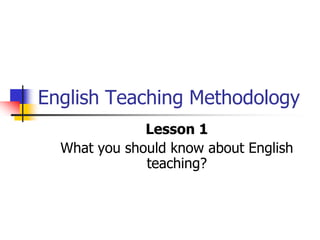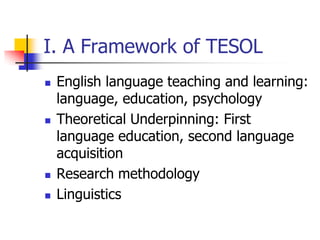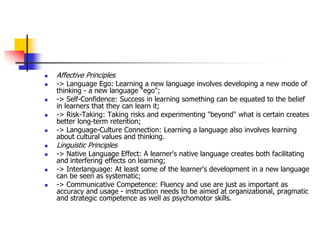Tesol lesson 1
- 1. English Teaching Methodology Lesson 1 What you should know about English teaching?
- 2. Reference Books ïŪ Techniques and Principles in Language Teaching, Diane Larsen-Freeman, Oxford University Press. ïŪ Principles of Language Learning and Teaching, H. Douglas Brown, Prentice Hall Regents. ïŪ Teaching by Principles, H. Douglas Brown, Prentice Hall Regents. ïŪ Approaches and Methods in Language Teaching, Jack C. Richards & Theordore S. Rodgers, Cambridge University Press. ïŪ An introduction to Second Language Acquisition Research. Diane Larsen-Freeman & Michael H. Long. ïŪ The Practice of English Language Teaching, Jeremy Harmer, Longman, Ltd. ïŪ Teaching English as a Second or Foreign Language. ïŪ Celce-Murcia, M. H&H ïŪ Second Language Teaching & Learning. David Nunan. (1995). H& H.
- 3. I. A Framework of TESOL ïŪ English language teaching and learning: language, education, psychology ïŪ Theoretical Underpinning: First language education, second language acquisition ïŪ Research methodology ïŪ Linguistics
- 4. II. Important terms in TESOL ïŪ TESOL, TEFL, TESL ïŪ TESOLâan acronym for teaching English to speakers of other languages, used, particularly in the USA, to describe the teaching of English in situations where it is either a second language or a foreign language. ïŪ TEFLâan acronym for teaching English as a foreign language, used to describe the teaching of English in situations where it is a foreign language. ïŪ TESLâan acronym for teaching English as a second language, used either to describe the teaching of English in situations where it is a second language or to refer to any situation where English is taught to speakers of other languages.
- 5. ïŪ ESL & EFL ESLâan abbreviation for English as a second language EFLâ an abbreviation for English as a foreign language * ph.D: pizza-hut delivery
- 6. ïŪ Deductive learning of grammarâ is an approach to language learning in which learners are taught rules and given specific information about a language. They then apply these rules when they use the language. For example, in the grammar translation method, specific grammar rules are given to learners and practice subsequently follows to familiarize students with the rule. The features of it are time-saving and suitable for adult learners who can afford abstract thinking. Besides it is widely used in EFL contexts where exposure to the target language is limited and the length of instruction time is short. (e.g. GTM, adult learners, FI/analytic learners, EFL contexts)
- 7. ïŪ Inductive learningâ is an approach to language learning in which learners are not taught grammatical or other types of rules directly but are left to discover or induce rules from their experience of using the language. Language teaching methods which emphasize use of the language rather than presentation of information about the language include the direct method, the communicative approach and counseling learning. The features of it are time-consuming and applicable to young learners in natural settings such as ESL contexts.
- 8. ïŪ performance and competence Performance-- a personâs actual use of language; how a person uses his knowledge of a language in producing and understanding sentences. Competence-- a personâs knowledge of a language People may have the competence to produce a long sentence but when they actually try to use this knowledge, there are reasons why they restrict it. For example, they may run out of breath or their listeners forget what has been said if the sentence is too long. Due to performance factors such as fatigue, lack of attention, nervousness or excitement, their actual use of language may not reflect their competence. The errors they make are described as examples of performance.
- 9. ïŪ Acquisition vs. learning Acquisition--the processes by which people naturally develop proficiency in a language Learning-- the processes by which people formally develop language proficiency.
- 10. ïŪ bottom-up processing v.s. top-down processing Top-down processingâa way in which humans analyze and process language as part of the process of comprehension and learning by making use of previous knowledge (higher-level knowledge) in analyzing and processing information which is received such as oneâs expectations, experience, schemata in reading the text. Bottom-up processingâ a way making use principally of information which is already present in the data (words, sentences, etc.) such as understanding a text mainly by analyzing the words and sentences in the text itself.
- 11. ïŪ Teacher-centered v.s. learner-centered teaching Teacher-centered (fronted) teachingâ a teaching style in which instruction is closely managed and controlled by the teacher, where students often respond in unison to teacher questions, and where whole-class instruction is preferred to other methods. Learner-centered teachingâ methods of teaching which emphasizes the active role of students in learning, tries to give learners more control over what and how they learn and encourages learners to take more responsibility for their own learning. It is encouraged by many current teaching approaches.
- 12. ïŪ Target language v.s. native language Target languageâthe language which a person is learning Native languageâ a first language or mother tongue/motherese which is acquired first.
- 13. ïŪ Form v.s. function ïŪ Formâ the physical characteristics of a thing-> in language use, a linguistic form is like the imperative ïŪ Functionâ a linguistic form can perform a variety of different functions: Come here for a drink-> invitation Watch out-> warning Turn left at the corner-> direction Pass the salt-> request
- 14. ïŪ CALL-- computer-assisted language learning ïŪ CAI: computer-assisted instruction ïŪ 3 P- a traditional classroom teaching procedure derived from the Situational Approach of presentation, practice and production
- 15. III. Research findings on SLA (a) Adults and adolescents can acquire a L2 (b) The learners creates a systematic IL with the same systematic errors as the child learning the L1 (c) There are predictable sequences in acquisition (d) Practice doesnât make perfect (e) Knowing a linguistic rule doesnât mean knowing how to use it (f) Isolated explicit error correction is usually ineffective (g) More adult learners fossilize (h) One cannot achieve nativelike command of a L2 in one hour a day (i) The learnersâ task is enormous since language is complex A meaningful context is paramount.
- 16. IV. Language Learning Principles ïŪ Principles of Language Learning Language learning principles are generally sorted into three sub-groupings: Cognitive Principles, Affective Principals and Linguistic Principles. Principles are seen as theory derived from research, to which teachers need to match classroom practices. Here are some brief summaries of the principles that fall into each grouping:
- 17. ïŪ Cognitive Principles ïŪ -> Automaticity: Subconcious processing of language with peripheral attention to language forms; ïŪ -> Meaningful Learning: This can be contrasted to Rote Learning, and is thought to lead to better long term retention; ïŪ -> Anticipation of Rewards: Learners are driven to act by the anticipation of rewards, tangible or intangible; ïŪ -> Intrinsic Motivation: The most potent learning "rewards" are intrinsically motivated within the learner; ïŪ -> Strategic Investment: The time and learning strategies learners invest into the language learning process.
- 18. ïŪ Affective Principles ïŪ -> Language Ego: Learning a new language involves developing a new mode of thinking - a new language "ego"; ïŪ -> Self-Confidence: Success in learning something can be equated to the belief in learners that they can learn it; ïŪ -> Risk-Taking: Taking risks and experimenting "beyond" what is certain creates better long-term retention; ïŪ -> Language-Culture Connection: Learning a language also involves learning about cultural values and thinking.
- 19. ïŪ Linguistic Principles ïŪ -> Native Language Effect: A learner's native language creates both facilitating and interfering effects on learning; ïŪ -> Interlanguage: At least some of the learner's development in a new language can be seen as systematic; ïŪ -> Communicative Competence: Fluency and use are just as important as accuracy and usage - instruction needs to be aimed at organizational, pragmatic and strategic competence as well as psychomotor skills.
- 20. ïŪ Affective Principles ïŪ -> Language Ego: Learning a new language involves developing a new mode of thinking - a new language "ego"; ïŪ -> Self-Confidence: Success in learning something can be equated to the belief in learners that they can learn it; ïŪ -> Risk-Taking: Taking risks and experimenting "beyond" what is certain creates better long-term retention; ïŪ -> Language-Culture Connection: Learning a language also involves learning about cultural values and thinking. ïŪ Linguistic Principles ïŪ -> Native Language Effect: A learner's native language creates both facilitating and interfering effects on learning; ïŪ -> Interlanguage: At least some of the learner's development in a new language can be seen as systematic; ïŪ -> Communicative Competence: Fluency and use are just as important as accuracy and usage - instruction needs to be aimed at organizational, pragmatic and strategic competence as well as psychomotor skills.




















